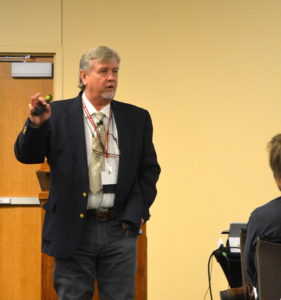Farm & Ranch
[AgriLife Today] Breeding soundness exams can prevent a financial wreck at the ranch

By: Blair Fannin
- Writer: Blair Fannin, 979-845-2259, [email protected]
COLLEGE STATION — The importance of a breeding soundness exam in herd bulls can prevent costly revenue losses, according to a Texas A&M AgriLife Extension Service economist.
Stan Bevers, AgriLife Extension economist in Vernon, shared the data from a large New Mexico ranch recently during the 62nd Texas A&M Beef Cattle Short Course in College Station.
In his evaluation of the past 25 years of income and expenses on the ranch, veterinary services and breeding per herd accounted for 3.1 percent of total expenses, or $27.88 per breeding female.
But in 2003, disaster set in. Bevers said pregnancy rates in 2003 dropped 50 percent.
“The ranch wasn’t doing any breeding exams and it hit them hard, very hard,” Bevers said. “The initial loss was $62,000 in calf sales. It also hurt their breakeven costs.”

Stan Bevers, Texas A&M AgriLife Extension Service economist in Vernon, discusses the importance of breeding soundness exams in herd bulls at the Texas A&M Beef Cattle Short Course recently. (Texas A&M AgriLife Extension Service photo by Blair Fannin)
Bevers said breakeven costs were calculated by taking the expenses divided by the total pounds of production. At the time pregnancy rates decreased, breakeven expenses increased from $1.19 per hundredweight to $1.75 per hundredweight.
The impact of the increase had significant repercussions later as the ranch looked to expand the herd.
“The board of directors purchased an additional 15,000 acres and wanted to stock it with replacement heifers,” Bevers said. “By missing out on the $62,000 in calf sales, needless to say, this set them back at least two years.”
Ultimately, Bevers said six bulls out of the 26-bull battery were sterile. A breeding soundness exam would have cost the ranch $1,560 versus losing $61,677 in calf sales.
“What this tells us is that it all begins with reproduction,” he said.
Bevers said cattle producers should view the expense of breeding soundness exams as purchasing an insurance policy.
“If she doesn’t get bred, nothing else matters. How much are you willing to assume, how much insurance can you afford to purchase?”
After Bevers’ presentation, he thanked the audience and told attendees he would be retiring after 27 years with AgriLife Extension at the end of August.
“It’s been a pleasure to serve you all of these years and provide you with information to help your operations become more profitable,” he said.
-30-
Find more stories, photos, videos and audio at http://today.agrilife.org
Farm & Ranch
Hazards of Backyard Poultry

By Barry Whitworth, DVM
Having backyard poultry is a popular agriculture enterprise. According to the United States Department of Agriculture, 0.8 percent of all households in the United States have chickens. People keep chickens for a variety of reasons with table eggs being one of the more common reasons.
Unfortunately, some of these poultry producers are not aware of the hazards that come with keeping poultry because many times they carry pathogens but appear healthy.
Chickens are carriers of several zoonotic diseases. These are diseases that can be passed from animals to humans. According to a recent survey in Pennsylvania, a majority of backyard poultry producers were aware of the dangers of avian influenza. However, this study also revealed that far fewer producers were aware of the risk of possible exposure to Salmonella and Campylobacter.
The lack of knowledge about the hazards of raising poultry likely contributes to the continued issues of Salmonella outbreaks associated with backyard poultry. In 2023, the Centers for Disease Control and Prevention reported 1,072 illnesses of Salmonella linked to backyard poultry, and 272 of those patients required hospitalization. Oklahoma reported 43 individuals with the disease.
To read more, pick up a copy of the April issue of NTFR magazine. To subscribe by mail, call 940-872-5922.
Farm & Ranch
Ag Elsewhere: Wyoming

By Tressa Lawrence
Babies are tucked away in every nook and cranny. Many ranchers across Wyoming have baby animals popping up all over this time of year.
Farm & Ranch
Ag Elsewhere: Montana

By Lindsey Monk
Another load of grain in to keep feeding the calves until the green grass can really start popping.
-

 Country Lifestyles1 year ago
Country Lifestyles1 year agoScott & Stacey Schumacher: A Growth Mindset
-

 Equine7 months ago
Equine7 months agoThe Will to Win
-

 Country Lifestyles7 years ago
Country Lifestyles7 years agoStyle Your Profile – What your style cowboy hat says about you and new trends in 2017
-

 Country Lifestyles4 years ago
Country Lifestyles4 years agoAmber Crawford, Breakaway Roper
-

 HOME7 years ago
HOME7 years agoGrazing North Texas – Wilman Lovegrass
-

 Country Lifestyles7 years ago
Country Lifestyles7 years agoDecember 2016 Profile, Rusty Riddle – The Riddle Way
-

 Country Lifestyles8 years ago
Country Lifestyles8 years agoJune 2016 Profile – The man behind the mic: Bob Tallman
-

 Outdoor9 years ago
Outdoor9 years agoButtercup or Primrose?






